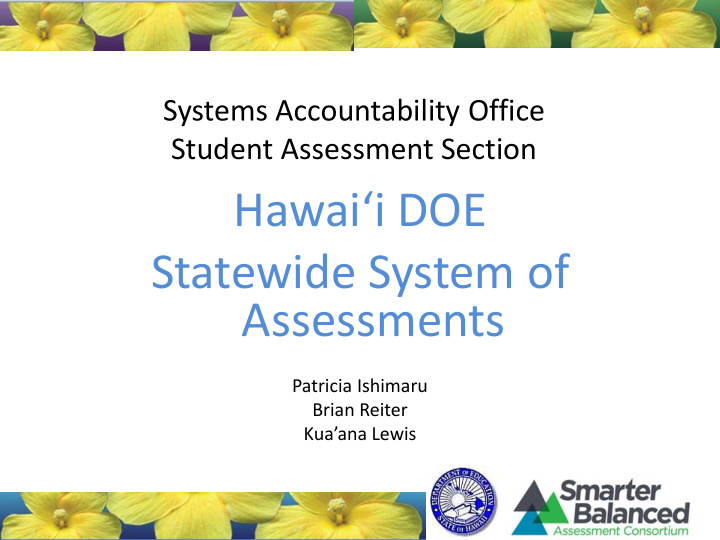



Systems Accountability Office Student Assessment Section Hawai‘i DOE Statewide System of Assessments Patricia Ishimaru Brian Reiter Kua’ana Lewis
Statewide System of Assessments • HSA → Bridge → Smarter Balanced Transitioning to measuring student achievement of the Common Core State Standards in English Language Arts/Literacy and Mathematics • HSAA → HSA -Alt • NAEP • EOC Exams - Algebra I, Algebra II, Expository Writing I, Biology I and U.S. History; HSA High School Science Assessment → Biology I EOC for NCLB accountability • ACT College and Career Readiness System
End-of-Course Exams
EOC Exams • End-of- Course exams are statewide summative assessments for the following courses: Algebra I Algebra II Biology I Expository Writing I U.S. History • EOC exams are administered at the end of instruction during the last three weeks of the course.
Implementation of End-of-Course Exams School Year Content Area EOC Exam 2012-13 2013-14 English Language Expository Writing I Arts Operational Algebra I Operational -Field • Fall 2013 - block - Test scheduled schools Mathematics • Spring 2013 - all only Algebra II schools • Spring 2014 - all schools Social Studies U.S. History Operational Operational • Fall 2012 - block - • Fall 2013 - block - scheduled schools scheduled schools Science Biology I only only • Spring 2013 - all • Spring 2014 - all schools schools
EOC Exams The EOC exams are used to: measure student proficiency of course content standards; inform instruction; and standardize course expectations. All public school students who are enrolled in Algebra I, Algebra II, Biology I, Expository Writing I, and/or U.S. History are required to take the corresponding EOC exam.
EOC Exams • Students are given one opportunity within a three - week testing window - with a second opportunity being allowed on a case -by- case basis. • The EOC exams include selected response and constructed response questions that are machine - scored. • When a student completes an exam, the student’s score is displayed on the student’s computer monitor and access to the student’s score report is available to the student’s teacher via the same online reporting system used for the HSAs.
EOC Exam Grading Policy Hawai‘i’s RTTT grant application states that EOC exam results will be used to determine a student’s grade for the course. The Department and the BOE will determine the percentage (between 15 and 40) of a course grade that will be based upon EOC exam results this spring. The policy will go into effect SY 2013 - 14.
Additional Information For additional information: • Contact Cara Tanimura , Director of the Systems Accountability Office, at (808) 586 - 3283 or Brian Reiter of the Systems Accountability Office, Student Assessment Section, at (808) 733 - 4100 or Brian_Reiter@notes.k12.hi.us • Visit http://www.alohahsap.org • Visit http://sao.sas.k12.hi.us
10
College and Career Readiness for Hawai‘i Students EXPLORE, PLAN, and ACT Plus Writing Spring 2013 11
2012-2013 Hawai‘i State Testing Program • EXPLORE – All Grade 8 and 9 Students* • PLAN – All Grade 10 Students* ACT Plus Writing – All Grade 11 Students* • Initial Test Date: April 23, 2013 *HIDOE approved/eligible public and charter school students 12
ACT’s Commitment to College and Career Readiness for all Students • Early Planning College and career readiness is a process not just an event • Curriculum-based Measures skills linked to college and career readiness standards and Common Core State Standards • Comprehensive Guidance A student is more than a test score • Student-centered Helps all students connect their education and career goals and aspirations 13
ACT’s College and Career Readiness System A comprehensive, longitudinal approach to education and career planning through student assessment, guidance, curriculum support, and school improvement. ACT research -based solutions help schools and states measure student progress toward college and career readiness. EXPLORE PLAN The ACT Plus Writing 8th and 9th grade 10th grade curriculum-based curriculum-based 11th and 12th grade educational and educational and curriculum-based career planning career planning assessment for program program learning outcomes; used for college admission and placement 14
The ACT • The most widely used college admission test in the U.S. – More than 2.8 million students in 2011 - 12 – 12 states have implemented ACT statewide • Accepted by all colleges and universities across the country Used by both 2 - and 4 - year colleges and universities to support student access and success English, Math, Reading, Science, Writing (national – Writing optional based on college preference) Includes a Career Interest Inventory 15
Overview of Student Data in the ACT Record More than 265 fields of data provide a complete student profile: – Personal/demographic data – Admissions/recruitment data – ACT scores, norms, and prediction research – High school courses and grades – Educational plans, interests, and needs – Activities and accomplishments
How Colleges Use The ACT • Recruiting • Institutional Research • Admission • Course Placement • Academic Advising • Dropout Intervention • Tutoring & Academic • Connecting Students to Support Campus Activities • Special Population Support • Early Alert and • Connecting Students to Intervention Campus Activities • Major/Career Planning • Orientation • Financial Aid/Scholarships The ACT provides postsecondary institutions with an objective, standardized measure of students’ academic readiness for college. 17
Additional Information For additional information: • Contact Cara Tanimura , Director of the Systems Accountability Office, at (808) 586 - 3383 or Patricia Ishimaru of the Systems Accountability Office, Student Assessment Section, at (808) 733 - 4100 or Patricia_Ishimaru@notes.k12.hi.us • Visit ACT’s Hawai‘i website http:// www.act.org/aap/hawaii • Visit ACT’s Course Placement Service website http://www.act.org/research/services/crsplace/ • Visit Hawai‘i DOE’s Student Assessment Section website http://sao.sas.k12.hi.us
Recommend
More recommend